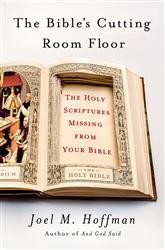The most reprinted book in the history of the world, read and reread by millions each year, the Bible continues to inspire the lives of many. Nevertheless, many of its core ideas are misunderstood.
Joel Hoffman’s new book, The Bible Doesn’t Say That: 40 Biblical Mistranslations, Misconceptions, and Other Misunderstandings, seeks to clarify some of the thorniest misinterpretations, which the author suggests are the products of “ignorance, accident, culture gap, mistranslation, and misrepresentation.” Hoffman, who has authored two other books on biblical interpretation, uses his third book on the Bible to tackle subjects in both the Tanakh (Hebrew Bible) and the New Testament — such as evolution, Jesus’s death, keeping kosher, and homosexuality.
Each chapter of The Bible Doesn’t Say That is devoted to an explanation of a biblical idea and involves a close reading of the text as well as parallels to contemporary life. For example, a chapter on slavery wrestles with what might appear to be the Bible’s support of this institution. Hoffman cites the story of George Washington and the cherry tree, contending that just as we would never suggest that this story advocates emulating Washington’s destruction of cherry trees, so should we not assume that the Hebrew Bible’s discussion of slavery indicates an endorsement of the institution. On the contrary, this Bible’s varied statements on slavery most likely suggest that slavery was recognized as a reality of the times, which required rules to prevent it from going unchecked. In the New Testament, statements about slavery exist for similar reasons.
In another chapter, Hoffman considers the origin and pronunciation of God’s name. To do this, the chapter takes the reader through a brief history of the development of the Hebrew alphabet, concluding that the four-letter name for God (technically called the tetragrammaton) is a collection of Hebrew vowels, the pronunciation of which is impossible to determine. However, misunderstanding of Hebrew grammar led to the pronunciation of the Yud-Hey-Vav-Hey as Yahweh, and ultimately led to its German pronunciation as Jehovah. The Jewish tradition sidestepped this error by assigning pronouncing Yud-Hey-Vav-Hey as Ado-nai.
The Bible Doesn’t Say That challenges the reader to think differently about many of the Bible’s core ideas. The book’s greater message — which is that the Bible must be read in consonance with the times in which it was written and with sensitivity to the nuances of its original language — is Hoffman’s most powerful point. Despite his academic background, the author writes in an accessible style that requires only an open mind and willingness to challenge long-held assumptions. A reader comes away understanding that while some of our misconceptions about the Bible are relatively minor, other misconceptions have led to significant misunderstandings, and even conflict, between people of faith.
Related Content:





